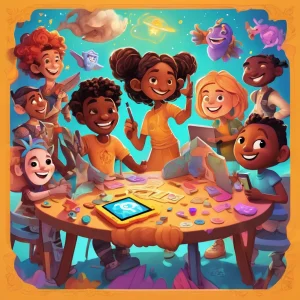Activity
Similar Activities
Gratitude Journey: Writing Thank-You Notes Experiment
Children’s Age: 6–8 years
Activity Duration: 10 – 20 minutes
A creative activity for children aged 7-8 to write thank-you notes, enhancing cognitive and communication skills.
Activity Duration: 10 – 20 minutes
Cultural Creatures: Stop-Motion Animation Adventure
Children’s Age: 4–9 years
Activity Duration: 10 – 25 minutes
An interactive activity using technology to create stop-motion animations exploring plants and animals from diverse cultures.
Activity Duration: 10 – 25 minutes
Nature Scavenger Hunt: Adventure in the Wild
Children’s Age: 4–9 years
Activity Duration: 10 minutes
An outdoor, nature-based activity promoting ecological awareness and cognitive development in children aged 4-9 years.
Activity Duration: 10 minutes
Enchanted Tales: Family and Friends Story Theater
Children’s Age: 2–7 years
Activity Duration: 10 – 25 minutes
An interactive storytelling activity promoting language, academic, and social development.
Activity Duration: 10 – 25 minutes
Musical Painting Fun: Expressive Art and Melodies
Children’s Age: 2–3 years
Activity Duration: 10 – 30 minutes
This activity involves children creating paintings while listening to music that matches the mood of sentences they choose. It helps with sensory development, and social-emotional …
Activity Duration: 10 – 30 minutes
Adventure of Rhyme and Move Outdoor Magic
Children’s Age: 3–4 years
Activity Duration: 10 – 25 minutes
"Rhyme and Move Outdoor Adventure" is a fun activity that combines nature-themed rhymes with movement in an outdoor setting. Children get to explore the outdoors, practice language…
Activity Duration: 10 – 25 minutes
Enchanted Tea Party Adventure: A Magical Journey
Children’s Age: 3 years
Activity Duration: 10 – 15 minutes
Join us for a Magical Tea Party Adventure! Enhance your child's play skills, social-emotional growth, and language abilities through a whimsical tea party experience. Gather teacup…
Activity Duration: 10 – 15 minutes
Outdoor Tea Party and Fix-it Fun for Toddlers
Children’s Age: 2–4 years
Activity Duration: 10 – 25 minutes
Let's create a fun Outdoor Tea Party and Fix-it Station for kids aged 1 to 3. Set up a table and chairs, play tea set, pretend tools, household items for fixing, a picnic blanket, …
Activity Duration: 10 – 25 minutes
Sensory Treasure Hunt: A Magical Exploration Journey
Children’s Age: 0 month – 6 years
Activity Duration: 10 minutes
Let's go on a Sensory Treasure Hunt! We will use our senses to explore different items like textures, scents, and sounds. You can feel, smell, and listen to each item while blindfo…
Activity Duration: 10 minutes
Enchanted Digital Storytelling Adventure through Nature's Wonders
Children’s Age: 5–18 years
Activity Duration: 50 minutes
Let's go on a "Digital Storytelling Adventure"! We'll create exciting stories using nature-themed digital images and fun drawing tools on a tablet or computer. Get ready to brainst…
Activity Duration: 50 minutes
Empathy Tales: Digital Story Clay Creations
Children’s Age: 3–18 years
Activity Duration: 10 – 25 minutes
In this activity, children aged 3 to 18 years old can explore empathy and creativity through a mix of digital storytelling and clay sculpting. You'll need a tablet or computer, cla…
Activity Duration: 10 – 25 minutes
Unity Blossoms: Family Handprint Tree
Children’s Age: 0 month – 6 years
Activity Duration: 10 minutes
Let's create a special "Family Handprint Tree" together! This fun activity brings families closer and helps kids grow in many ways. You'll need paper, colorful paints, brushes, wet…
Activity Duration: 10 minutes




























